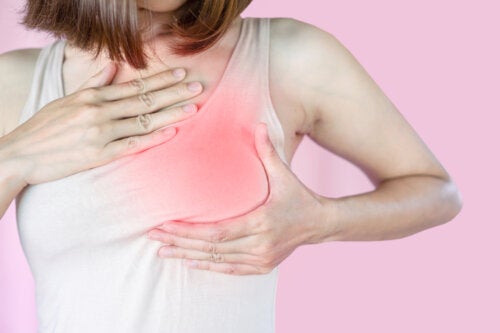Sore Nipples During Breastfeeding: 10 Tips
Sore nipples are a common condition in new mothers. In the following article, we'll share 10 tips to prevent them!

Sore nipples during breastfeeding are one of the most common reasons that lead women to abandon exclusive breastfeeding. In turn, the drawbacks that cause this outcome are problems with nipple positioning or latch-on, infections, inverted or flat nipples, vasospasm, or disorders in the baby’s oral cavity.
Whatever the cause, there’s a lot you can do to improve sore nipples and we’ll tell you how below. Don’t miss it!
Sore nipples during breastfeeding
Nipple injury is a very common complication among breastfeeding women and can appear with intense pain or burning in the breasts, especially when placing the baby on them to breastfeed.
Another difficulty caused by these injuries is that they can be recurrent, and thus, reduce the rate of epithelialization and delay healing. Consequently, it causes a serious impact on breastfeeding and conditions its continuity.
That said, it’s crucial to implement the necessary strategies in order to improve the condition of mom’s nipples, and we’re going to give you 10 recommendations to achieve it.
1. Correct poor positioning and latching
Correcting infant positioning and latching is one of the most common experience-based recommendations for managing nipple irritation and soreness.
When these adjustments are made within the first week of birth, they result in longer-lasting breastfeeds and even fewer problems during breastfeeding.
2. Evaluate the possibility of mastitis
In cases of mastitis, only part of the breast is affected, which manifests itself as a hard, red swelling on the surface of the breast that causes intense pain at the slightest touch. The mother may even have a fever and feel faint.
Read also: Mastitis: Causes, Symptoms and Treatment

3. Moisturize the skin
Maintaining the protective lipid layer of the skin surface is essential during lactation, and this is achieved through the application of creams. When the nipples are irritated or show pain due to friction, lanolin can be used to relieve the discomfort. Some comparative studies evaluate the benefits of lanolin versus breast milk itself and position lanolin as one of the most effective agents for resolving nipple skin irritations.
4. Apply calendula oil
Topical application of calendula oils for the treatment of cracked and sore nipples during lactation has beneficial effects. This compound has important anti-inflammatory, comforting, and regenerative properties. At the same time, it’s a natural moisturizer that generates important changes in the skin.
You may be interested in: Natural Remedies for Postpartum Recovery
5. Resorting to corticosteroid creams
Dermatitis can be treated by avoiding irritants and can be treated by a short course of treatment with topical corticosteroid creams. There are some cases in which nipple psoriasis develops, and these creams are the first therapeutic option.
However, this type of medication shouldn’t be abused and should be indicated by a physician, weighing the benefits and risks of using it.
6. Apply warm cloths to the breasts
It’s common for breastfeeding women to experience breast engorgement, plugging of the ducts, or vasospasm of the nipples. One of the measures to avoid these conditions is to apply warm compresses over the areola before feeding begins.
7. Wear loose-fitting clothing to avoid sore nipples
Clothing isn’t a major factor in the genesis of nipple injuries during lactation. However, a good choice of clothing helps to prevent these frequent problems.
Wearing tight-fitting bras causes friction and constant rubbing, with the consequent development of dermatitis and nipple irritation. For this reason, it’s best to choose garments made of natural materials that are loose-fitting.
8. Evaluate the oral cavity of infants
The infant should be evaluated for orofacial abnormalities, such as protrusion, elevation, lateralization, or tongue grouping, suggestive of ankyloglossia.
Palatal anomalies, such as bubble palate or high-arched palate, interfere with breastfeeding and are assessed visually.
When infants have ankyloglossia and feeding difficulties, a frenotomy in the first week of life is more beneficial than when performed later.
9. Evaluate the appropriateness of pacifier or bottle use
One of the factors linked to nipple injury is the use of a pacifier by the infant. This practice interferes with the infant’s attachment to the mother’s breast and may change the correct sucking pattern. Thus, the woman is more likely to sore nipples or skin lesions on her breasts.

10. Avoid nipple vasospasm
Vasospasm is the contraction of the blood vessels that supply the skin and muscles of the nipple. This usually causes pain and a burning sensation in the area.
The most common causes are exposure to cold, or physical and emotional stress. Therefore, caffeine, smoking, and staying in environments with extreme temperatures should be avoided.
Warm compresses quickly relieve the pain and correct positioning and latching by the infant should be encouraged.
Sore nipples aren’t just a skin issue
Sore nipples along with the accompanying pain interfere with the mother’s mood, general activity, and sleep.
Therefore, more emphasis needs to be placed on educating mothers about correct positioning and latch-on within the first week after birth to prevent sore and irritated nipples.
